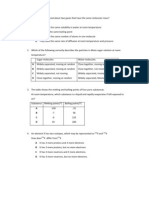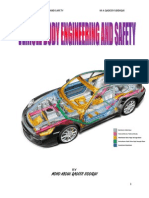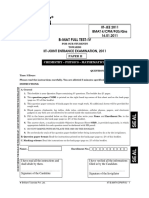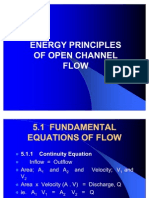Subject Knowledge Tests: Pre-16 Chemistry
Subject Knowledge Tests: Pre-16 Chemistry
Uploaded by
PolEak ZincMelodicCopyright:
Available Formats
Subject Knowledge Tests: Pre-16 Chemistry
Subject Knowledge Tests: Pre-16 Chemistry
Uploaded by
PolEak ZincMelodicOriginal Description:
Original Title
Copyright
Available Formats
Share this document
Did you find this document useful?
Is this content inappropriate?
Copyright:
Available Formats
Subject Knowledge Tests: Pre-16 Chemistry
Subject Knowledge Tests: Pre-16 Chemistry
Uploaded by
PolEak ZincMelodicCopyright:
Available Formats
Subject knowledge tests: pre-16 chemistry
Test 1: questions
For each question, select the correct answer – A, B, C or D.
1 Which statement best explains why solid A melts at a lower temperature than solid B?
A The attractions between particles in solid A are stronger than those between
particles in solid B.
B The particles in solid A are larger than the particles in solid B.
C The mass of particles in solid A is greater than the mass of particles in solid B.
D The attractions between particles in solid A are weaker than those between particles
in solid B.
2 1 kg of charcoal (pure carbon) is fully burned in oxygen. What is the mass of carbon dioxide
produced?
C + O 2 → CO 2
A r values: C = 12; O = 16
A 2.600 kg
B 1.571 kg
C 1.000 kg
D 3.667 kg
3 When calcium carbonate (marble chips) is added to dilute hydrochloric acid, a reaction
occurs:
2HCl(aq) + CaCO 3 (s) CaCl 2 (aq) + H 2 O(l) + CO 2 (g)
Which is the best method of measuring the rate of reaction?
A Record the change in temperature over time.
B Record the volume of carbon dioxide gas produced over time.
C Change the concentration of the acid.
D Change the size, or surface area of the marble chips.
© Royal Society of Chemistry 2018
4 The mouth of a bottle full of air is closed off with a cork.
What is in between the particles in the bottle?
A Air
B Bacteria
C Dust
D Nothing
5 50 g sugar (sucrose) is added to 200 g water in a beaker. The sugar is stirred until it has
dissolved completely and cannot be seen. What is the mass of the sugar solution?
A Less than 250 g because the sugar disappears when it dissolves.
B Less than 250 g because a gas is given off.
C 250 g because the sugar melts into the water, but is still there.
D 250 g because the sugar mass is spread through the solution.
6 A piece of solid phosphorus is put in a flask and covered with water. The flask is sealed with
a bung and left on a sunny windowsill. The mass of the flask, bung, phosphorus and water is
600 g. The sun shines on the flask. The contents get hot. The water evaporates. The
phosphorus catches fire, making white smoke.
Which statement best explains what happens to the mass of the flask and its contents after
the changes?
A The mass goes down because the solid changes to a gas.
B The mass stays the same because the flask is sealed.
C The mass goes up because phosphorus burned in oxygen in the flask.
D The mass goes down because phosphorus is destroyed.
© Royal Society of Chemistry 2018
7 When methane gas burns with a yellow flame, energy is released.
Why is energy released when methane burns?
A Energy comes from the flame.
B Energy stored in the methane is released on burning.
C Burning any fuel releases energy.
D Energy is released when carbon dioxide and water are made as products.
8 When a car is driven, the pressure in the car’s tyres increases during the journey. Why does
the pressure increase?
A The tyres warm up as the car moves.
B The air particles move around more in a hot tyre.
C The air particles expand as the tyre gets hot.
D The people in the car put pressure on the tyres.
9 Here is an equation for the reaction between solid silver and iron(III) ions:
Ag(s) + Fe3+(aq) ⇌ Ag+(aq) + Fe2+(aq)
What does the ⇌ symbol mean?
A The reaction goes forwards then backwards.
B The amounts of chemicals either side are equal.
C The reaction reaches equilibrium
D The reaction is balanced overall.
10 What is meant by an “empirical” formula for a substance?
A A formula measured by experiment.
B The simplest numerical ratio of the types of atom present.
C Another term for the molecular formula.
D A formula indicating which elements are present.
© Royal Society of Chemistry 2018
11 Which of these procedures could a chemist use to separate the components of the
compound lead bromide?
A Dissolving, then filtering.
B Dissolving, then chromatography.
C Melting, then electrolysis.
D None, because a compound cannot be split up.
12 Iron and sulfur react according to the equation:
Fe(s) + S(s) → FeS(s)
What is left in the reaction vessel when 112 g iron and 80 g sulfur react?
A r values: Fe = 56; S = 32
A 192 g FeS
B 176 g FeS and 16 g sulfur
C 176 g FeS only
D 192 g FeS 2
13 What are the units for relative atomic mass, A r ?
A Atomic mass units
B g–9
C kg–12
D There are no units for relative atomic mass.
14 Which of these substances could be a “chemical element”?
A A colourless liquid that can be split into two liquids by distillation.
B A silver solid that changes to a white solid on heating.
C A dark blue liquid that gives three lines in a chromatography test.
D A white solid that gives off carbon dioxide gas when heated.
© Royal Society of Chemistry 2018
15 Here are the colours of Universal Indicator solution at different pH values but the same
concentration:
Which response gives the correct order for the numbers on the pH scale?
A Strong alkali – weak alkali – distilled water – weak acid – strong acid
B Weak acid – strong acid – neutral – strong alkali – weak alkali
C Strong acid – weak acid – neutral – weak alkali – strong alkali
D Weak alkali – strong alkali – distilled water – strong acid – weak acid
16 Which statement is the best definition for rate of reaction?
A Amount of product produced in a unit of time.
B Volume of gas produced in a unit of time.
C Amount of product produced until a reagent runs out.
D Amount of product produced in the first minute.
17 Which of the following solutions is likely to have the highest pH?
A A weak dilute acid.
B A strong dilute acid.
C A weak concentrated acid.
D A strong concentrated acid.
© Royal Society of Chemistry 2018
18 When calcium carbonate (marble chips) is added to dilute hydrochloric acid, a reaction
occurs:
2HCl(aq) + CaCO 3 (s) CaCl 2 (aq) + H 2 O(l) + CO 2 (g)
Eventually the reaction stops. A colourless solution remains.
Why does the reaction stop?
A All the calcium carbonate has reacted.
B The reaction has reached equilibrium.
C The amounts of reagents and products have equalised.
D No more gas can be produced.
19 Here is the equation for the reaction between two complex ions:
Co(H 2 O) 6 2+ + 4Cl– ⇌ CoCl 4 2– + 6H 2 O
PINK BLUE
(cobalt(II) (cobalt(II)
hexahydrate tetrachloro
complex ion) complex ion)
What will happen if a lot of water is added when the reaction is at equilibrium?
A A pink colour would be produced.
B A blue colour would be produced.
C A purple colour would be produced.
D It’s impossible to tell without knowing the original colour.
20 Which of the following lists include compounds only?
A Methane, carbon dioxide, air
B Water, iron, crude oil
C Air, crude oil, iron
D Carbon dioxide, water, methane
© Royal Society of Chemistry 2018
21 Which of these properties apply to a single atom of copper?
Colour: red – orange
Malleable: can be shaped
Ductile: can be pulled into wires
Melting point: melts at 1083 °C
A All of them
B None of them
C Colour and melting point only
D Colour only
22 When a candle burns the wax disappears and eventually the flame goes out. What is
happening?
A The wax melts then evaporates with the heat of the flame.
B The wick burns creating heat to evaporate the wax.
C The wax melts then burns in oxygen in the air.
D The wax stores energy which is given off when the candle burns.
23 The equation for the reaction between solid silver and iron(III) ions is:
Ag(s) + Fe3+(aq) ⇌ Ag+(aq) + Fe2+(aq)
Which is the best explanation for what would happen when an aqueous solution of iron(II)
ions is added to an aqueous solution of silver ions?
A No change because the reaction is at equilibrium.
B Silver appears in the test tube and the reaction stops.
C Silver appears, then reacts to form silver ions, then silver re-appears.
D Silver appears in the test tube.
© Royal Society of Chemistry 2018
24 What is an “exothermic” reaction?
A A reaction that is instantaneous.
B A reaction that absorbs energy from the environment.
C A reaction that transfers energy to the environment.
D A reaction that has a very fast rate.
25 In which list are these chemical elements in the correct order of increasing particle
movement?
A Oxygen, mercury, gold
B Mercury, gold, oxygen
C Gold, mercury, oxygen
D The particles move the same amount in all three.
26 Which statement is the best description of the properties of an ACID?
A An acid eats material away.
B An acid burns skin and/or materials.
C An acid reacts with metals to produce hydrogen gas.
D An acid reacts with alkalis to produce carbon dioxide.
© Royal Society of Chemistry 2018
27 Which two energy profiles represent exothermic reactions?
(vertical axis: energy, horizontal axis: course of reaction)
1 2
3 4
A 1,2
B 2,3
C 1,4
D 3,4
28 A vitamin C tablet is put in water. A gas is produced as the tablet dissolves. Where did the
gas come from?
A It was formed in a chemical reaction.
B It was in the tablet already in solid form.
C It was hydrogen or oxygen from the water.
D It was gaseous vitamin C from the tablet.
© Royal Society of Chemistry 2018
29 Hydrochloric acid and aqueous sodium hydroxide react together releasing energy
HCl(aq) + NaOH(aq) NaCl(aq) + H 2 O(l) ∆H = –ve
Which is the best explanation for energy being released?
A Bonds between hydrogen and chlorine break.
B Bonds between sodium and hydroxide ions break.
C Sodium and chloride ions bond together forming sodium chloride.
D Hydrogen and hydroxide ions bond together forming water molecules.
30 Hydrogen peroxide decomposes to produce water and oxygen gas:
2H 2 O 2 (l) 2H 2 O(l) + O 2 (g)
The reaction occurs slowly at room temperature. Changing which two factors would increase
decomposition rate?
A Volume of oxygen, temperature
B Concentration of hydrogen peroxide, volume of oxygen
C Temperature, volume of water
D Concentration of hydrogen peroxide, adding a catalyst
31 Which statement is the best definition for “freezing point”?
A The temperature at which liquid water becomes solid ice, 0 °C.
B The temperature at which any liquid becomes solid.
C Any temperature below 0 °C
D The temperature at which particle movement stops.
32 Which list names only everyday substances which are alkaline?
A Baking soda, toothpaste, oven cleaner
B Fizzy drink, orange juice, vinegar
C Baking soda, fizzy drink, oven cleaner
D Toothpaste, orange juice, vinegar
© Royal Society of Chemistry 2018
You might also like
- Lecture 6 Wire DrawingDocument45 pagesLecture 6 Wire Drawingisrael100% (2)
- June 1999 Paper 1Document16 pagesJune 1999 Paper 1YasirNo ratings yet
- Chemistry 150 MCQ PracticeDocument38 pagesChemistry 150 MCQ PracticeGrilled CheezNo ratings yet
- 2020 Yearly Exam SolutionsDocument19 pages2020 Yearly Exam SolutionsYu-Tang LinNo ratings yet
- 2016 Sec 4 Pure Chemistry SA2 Singapore Chinese Girls' SchoolDocument62 pages2016 Sec 4 Pure Chemistry SA2 Singapore Chinese Girls' SchoolWANG JIXIANG JASON HCINo ratings yet
- 2020 Yearly Exam PaperDocument22 pages2020 Yearly Exam PaperYu-Tang LinNo ratings yet
- Chemistry Presentation: Multiple Choice QuestionsDocument118 pagesChemistry Presentation: Multiple Choice QuestionsKhiZra ShahZadNo ratings yet
- Filtrate: © UCLES 2021 0620/11/O/N/21Document49 pagesFiltrate: © UCLES 2021 0620/11/O/N/21gabrielwong20000No ratings yet
- University of Cambridge International Examinations General Certificate of Education Ordinary LevelDocument12 pagesUniversity of Cambridge International Examinations General Certificate of Education Ordinary LevelStuart KanyesigyeNo ratings yet
- CHEMISTRYDocument41 pagesCHEMISTRYLindsayyNo ratings yet
- 1 in Which Option Do The Three Particles Each Have The Same Number of ElectronsDocument12 pages1 in Which Option Do The Three Particles Each Have The Same Number of Electronssololexzib100% (1)
- MCQ - WS! June 2023Document7 pagesMCQ - WS! June 2023Prakriti DhakalNo ratings yet
- CHMBKLTDocument23 pagesCHMBKLTелизабетаNo ratings yet
- 2018 Sec 4 Pure Chemistry SA2 Geylang Methodist SchoolDocument42 pages2018 Sec 4 Pure Chemistry SA2 Geylang Methodist SchoolginkaineoNo ratings yet
- Chem G10-Quiz1 19-5-2020Document13 pagesChem G10-Quiz1 19-5-20201211200107No ratings yet
- 2019 Sec 4 Pure Chemistry SA2 Geylang MethodistDocument32 pages2019 Sec 4 Pure Chemistry SA2 Geylang MethodistErOn TaNNo ratings yet
- Chemistry Deyi 4EChemPrelim2009P1Document16 pagesChemistry Deyi 4EChemPrelim2009P1uchiloveNo ratings yet
- Chemistry MCQ BookDocument594 pagesChemistry MCQ Booksamipyawagle123No ratings yet
- Summative Prep 2 (Chem)Document14 pagesSummative Prep 2 (Chem)MCHNo ratings yet
- 2018 Y4 Prelim P2Document16 pages2018 Y4 Prelim P2Fangru CaoNo ratings yet
- Humaira WaliDocument11 pagesHumaira WaliGM Ali KawsarNo ratings yet
- Cambridge International AS & A Level: Chemistry 9701/12Document16 pagesCambridge International AS & A Level: Chemistry 9701/12spandan BhattaraiNo ratings yet
- MYE 2018 CHEM S3A QP FinalDocument17 pagesMYE 2018 CHEM S3A QP FinalVina Octavia AzzahraNo ratings yet
- 5070 s15 QP 12Document13 pages5070 s15 QP 12Saima SohailNo ratings yet
- Chemistry 2Document12 pagesChemistry 2kahguaNo ratings yet
- 5073 Prelim P1 QuestionsDocument13 pages5073 Prelim P1 QuestionsPallab SarkarNo ratings yet
- Practice Paper 2 Sem1 Science XDocument4 pagesPractice Paper 2 Sem1 Science Xbanop6486No ratings yet
- Chemistry-2-2nd-Quarter-Final-Exam 2019 - 2020-PMDocument9 pagesChemistry-2-2nd-Quarter-Final-Exam 2019 - 2020-PMAnalynAsuncionAtaydeNo ratings yet
- Copy of MCQ Oct Mid TermDocument12 pagesCopy of MCQ Oct Mid TermethanbrubakerNo ratings yet
- 5070 w09 QP 1Document16 pages5070 w09 QP 1mstudy123456No ratings yet
- Post 16 Test 1 QuestionsDocument11 pagesPost 16 Test 1 Questionschristianaorakwe63No ratings yet
- Section A (Question) FINALDocument8 pagesSection A (Question) FINALcalderteoNo ratings yet
- HomeworkDocument7 pagesHomeworkBramasta bumiNo ratings yet
- ChemistryDocument10 pagesChemistrykahgua0% (1)
- Hydrogen QDocument9 pagesHydrogen QRDXNo ratings yet
- Chem Mcqs Test 5Document12 pagesChem Mcqs Test 5TeekayNo ratings yet
- WS Grade 9 IG Chemistry 22-23 - Revision For SA2Document14 pagesWS Grade 9 IG Chemistry 22-23 - Revision For SA2SiyaNo ratings yet
- Wa0007Document18 pagesWa0007Aaron BvitiraNo ratings yet
- 1.1 Particulate Nature of Matter and Chemical Change P1 MSDocument6 pages1.1 Particulate Nature of Matter and Chemical Change P1 MSCicy IrnaNo ratings yet
- Joint Universities Preliminary Examinations Board 2015 Examinations Chemistry: Sci-J153 Multiple Choice Questions: Answer All QuestionsDocument11 pagesJoint Universities Preliminary Examinations Board 2015 Examinations Chemistry: Sci-J153 Multiple Choice Questions: Answer All QuestionsDeborahNo ratings yet
- Read These Instructions FirstDocument7 pagesRead These Instructions FirstSalman Ul MoazzamNo ratings yet
- Multiple Choice Questions (40 Marks) : Gas Mixture WaterDocument12 pagesMultiple Choice Questions (40 Marks) : Gas Mixture Water584ct6tgwyNo ratings yet
- Chem CH 1 MCQDocument5 pagesChem CH 1 MCQchoudharygaurav1313No ratings yet
- Carbon and Its Compounds: A. GraphiteDocument11 pagesCarbon and Its Compounds: A. Graphiteleticia karungiNo ratings yet
- p1 ChemistryDocument15 pagesp1 ChemistryHumza SohailNo ratings yet
- NL MCQ Challenge 03Document5 pagesNL MCQ Challenge 03Alvin Lee100% (1)
- NL MCQ Challenge 01Document4 pagesNL MCQ Challenge 01Alvin LeeNo ratings yet
- Test 1 Paper2 - Grade 10-11 IGCSE - 2020 - MoodleDocument13 pagesTest 1 Paper2 - Grade 10-11 IGCSE - 2020 - MoodleJadNo ratings yet
- 5070 s11 QP 11Document16 pages5070 s11 QP 11chuasioklengNo ratings yet
- 1993 Paper 2Document7 pages1993 Paper 2api-3826629No ratings yet
- University of Cambridge International Examinations General Certificate of Education Ordinary LevelDocument16 pagesUniversity of Cambridge International Examinations General Certificate of Education Ordinary Levellovedale156No ratings yet
- Chemistry November 2008 Paper 3Document17 pagesChemistry November 2008 Paper 3wb4qv7yzvzNo ratings yet
- North Vista 2015 Prelim Paper 1Document20 pagesNorth Vista 2015 Prelim Paper 1GM MonsterEtaNo ratings yet
- Workbk 10Document177 pagesWorkbk 10Manushree NayakNo ratings yet
- Moles and EquationsDocument12 pagesMoles and Equationsdivisha.ing14No ratings yet
- NL MCQ Timed Practice 10 (R96)Document4 pagesNL MCQ Timed Practice 10 (R96)Alvin LeeNo ratings yet
- 81-The-Characteristic-properties-of-acids-and-bases-Topic-Booklet-1-CIE-IGCSE-ChemistryDocument11 pages81-The-Characteristic-properties-of-acids-and-bases-Topic-Booklet-1-CIE-IGCSE-ChemistryFaeequa nasrahNo ratings yet
- 2023 CGS Chemsitry Prelim P1Document14 pages2023 CGS Chemsitry Prelim P1tarankaur401No ratings yet
- Practice Makes Perfect in Chemistry: Oxidation-ReductionFrom EverandPractice Makes Perfect in Chemistry: Oxidation-ReductionRating: 5 out of 5 stars5/5 (1)
- Molecular Orbital TheoryDocument26 pagesMolecular Orbital TheorySri Santika FujiantiNo ratings yet
- Tray DryerDocument16 pagesTray DryerZalina Samsuddin100% (1)
- Ena Sensory PDFDocument27 pagesEna Sensory PDFMohan PNo ratings yet
- Fund Chem Reax Eng CH 2Document11 pagesFund Chem Reax Eng CH 2Muhammad Syarif HidayatullahNo ratings yet
- Hyguard EXDocument20 pagesHyguard EXseemeshwariNo ratings yet
- LockSets Catalogue - Residential CatalogueDocument16 pagesLockSets Catalogue - Residential Cataloguejoshua.kmbanayatNo ratings yet
- Class 10 Chemistry Plaster of Paris PresentationDocument8 pagesClass 10 Chemistry Plaster of Paris PresentationprakashNo ratings yet
- 2011specific Kobelco BookDocument169 pages2011specific Kobelco Bookmas_munir7174No ratings yet
- Önorm S 2076-1 - 2000 - 03 - 01Document10 pagesÖnorm S 2076-1 - 2000 - 03 - 01Berkay GünerNo ratings yet
- EBOOK System For Ophthalmic Dispensing E Book 3Rd Edition Ebook PDF Download Full Chapter PDF KindleDocument61 pagesEBOOK System For Ophthalmic Dispensing E Book 3Rd Edition Ebook PDF Download Full Chapter PDF Kindlerachel.chambers728100% (43)
- Double Block Bleed TOSVDocument8 pagesDouble Block Bleed TOSVplanet123No ratings yet
- Grade 10 Chemistry Chapter Ionic and Net Ionic EquationsDocument14 pagesGrade 10 Chemistry Chapter Ionic and Net Ionic EquationssaraNo ratings yet
- River Preservation: Group 4 Elle, Eunillo Dio Pepito, Darius Earl Ybarley, Joanna GraceDocument49 pagesRiver Preservation: Group 4 Elle, Eunillo Dio Pepito, Darius Earl Ybarley, Joanna GraceCarl Neil DomingoNo ratings yet
- Safety Data Sheet: 1 IdentificationDocument11 pagesSafety Data Sheet: 1 IdentificationKara WhiteNo ratings yet
- Is 458 2003Document68 pagesIs 458 2003Yazer ArafathNo ratings yet
- Chapter 1 Solid State PrinciplesDocument65 pagesChapter 1 Solid State PrinciplesPeter YekNo ratings yet
- Chem PP2Document13 pagesChem PP2Andrew NyongesaNo ratings yet
- Livotrit PaperDocument7 pagesLivotrit Papersajad ahmad MalikNo ratings yet
- Vehicle Body Engineering by M A Qadeer SiddiquiDocument143 pagesVehicle Body Engineering by M A Qadeer SiddiquiAbdul Qadeer Siddiqui100% (12)
- Outline of Hazmat Study GuideDocument2 pagesOutline of Hazmat Study Guidernp2007123No ratings yet
- Module 2 - Che 408Document20 pagesModule 2 - Che 408John Emmanuel Abel Ramos100% (1)
- Chapter I. Symmetry and Group TheoryDocument183 pagesChapter I. Symmetry and Group Theorychemical33No ratings yet
- Iit 2011 FST4 QNS P2Document27 pagesIit 2011 FST4 QNS P2Sarvesh DubeyNo ratings yet
- Eletrochemistry Anilkumar HssliveDocument3 pagesEletrochemistry Anilkumar HssliveMathew YoyakkyNo ratings yet
- Cat Ultra Synthetic Generator Grease: Long Life, Extreme PressureDocument2 pagesCat Ultra Synthetic Generator Grease: Long Life, Extreme PressureEslam MahfouzNo ratings yet
- NW Physical Science Grade 12 SEPT 2022 P2 and MemoDocument38 pagesNW Physical Science Grade 12 SEPT 2022 P2 and MemoMatthew KillianNo ratings yet
- Principle of Open Channel FlowDocument39 pagesPrinciple of Open Channel FlowEugene Acuin Jaraplasan100% (2)
- Cargo Handling PDFDocument26 pagesCargo Handling PDFRivano Tetrapoik100% (1)
- The Clay Research Group The Clay Research GroupDocument9 pagesThe Clay Research Group The Clay Research Groupvedwards10No ratings yet

























































































